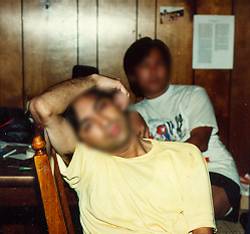 |  |
Don't Panic
Don't panic if you set the speed of a roll of print film incorrectly. First, unlike slide films, print films have a higher latitude (tolerance) i.e. the print may still look fine even if the film is over-exposed or under-exposed a little. Second, sometime the so-called "incorrect" film speed may bring you a better result, depending on what you expect to see in the photo. Galen Rowell, a prominent nature photographer, even deliberately set the ISO of films different than the ISO specified by the manufacturer in order to get the best result.Look at the following two pitcures (Because I didn't get a consent of release from the people in the pictures, the following illustration is presented with blurred faces):
 |  |
The film speed was supposed to be ISO 100. In the first shot (left) the film speed was set correctly, but the detail of the shirt was washed out. In the second shot (right) the film speed was pushed to ISO 400. By pushing the file speed from ISO 100 to 400, the film was under-exposed. Nevertheless, the texture and the color of the shirt are much clearer.
I cannot judge which shot is better. The first picture shows no detail on the shirt, but the skin tone on the subject's face is lighter than the second one, and thus looks more pleasant (sorry, I cannot show his face. Just use your imagination). The effect of the second picture is exactly opposite to the first one--great detail in the shirt but dark skin tone on the face.
Recommendations
- If the colors of the subject and the clothing are highly contrast (e.g. a White girl wearing a black dress or a Black girl wearing a white dress), bracket your exposures or push up your film speed.
- If your model is your wife or girl friend, sacrifice the detail of her clothing and make her skin tone look pretty. If your subject is your husband or boy friend, get the detail of his garment such as the Polo or Pierre Cardin logo.